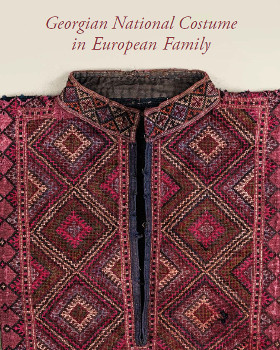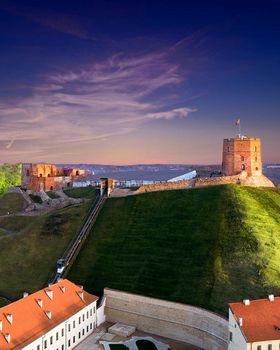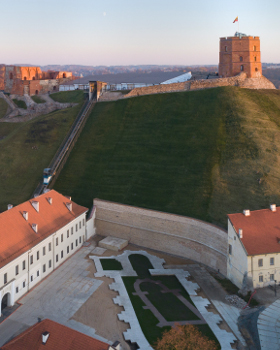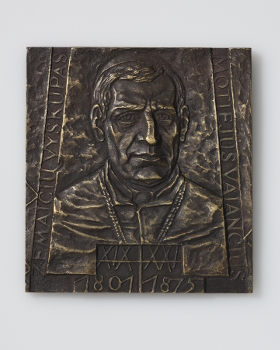Exhibition Georgian National Costume in European Family

The exhibition “Georgian National Costume in European Family” is open from 1 to 3 December 2017 at The National Museum of Lithuania, Arsenalo St. 1, Vilnius. The exhibition contains costumes from The House of Georgian National Costume, photos from The Georgian Art Palace and Cloisonné Enamel by Sofi Etsadashvili.
Georgian National Costume
Georgian national costume vividly reflects the history of Georgia, the values and cultural diversity of its people. History of Georgian clothing can be traced back the fifth-sixth century, in historical sources, church paintings and frescos, as well as works of Georgian authors.
The exhibition presents collection of national clothing, from early Christian period to the beginning of the 21st century, offering a stunning original finery of Georgian royal clothing of the medieval centuries and apparel of Georgian noblemen and noblewomen of later period.
The collection provides an insight into the culture and history of Georgia, the first nation in the Caucasus region to produce fabric. National costume has transformed in accordance with country’s historical development. The Persian conquests led to the modification of indigenous clothes in line with the Persian style. The close ties with Byzantium gave rise to new tendencies and stylistic elements in the clothing of Georgian royals.
At the beginning of the 19th century European influence in Georgian national costume became particularly visible. Garments made in the hosiery factories in Paris, London and Vienna greatly impressed the people of Georgia and, as a result, the style of clothing began to align with European fashion.
With the beginning of the communist era in the 20th century, the national style and many other traditions came to be labeled as outdated and the attire of the Georgian society changed dramatically. Remarkably, some of the garments depicted on photos belonged to the representatives of Georgia’s royal and noble families. In 1921, following the Bolshevik annexation, a considerable number of suits were confiscated from their owners and given to the Tbilisi Movie Studio. These precious costumes performed in historical Georgian movies and are today preserved in the Georgian State Museum of Theatre, Music, Film and Choreography – Art Palace.
The exposition depicts also the evolution of the Georgian “Chokha”, the high-necked wool coat worn by Georgian men for over a thousand years. This costume is particularly notable for the cartridge cases adorning its breast. There are several kinds of “Chokhas” in Georgia, which are set apart by region, length, number of breast panels, shape of the sleeves, as well as by design.
After the regaining independence in 1991, many Georgians brought it back as a source of national pride. Recently, the “Chokha”, made an international impact, notably in the works of luxury fashion house Balenciaga and Georgia-born British designer David Koma. Georgian designers are now producing modern versions of the Chokha, including a version for women.
The House of Georgian Costume was established in Tbilisi, in 2013 by Ms. Ekaterina Javakhishvili. The House plays important role in preserving and popularization of Georgian costume, presenting it intensively in many international exhibitions and art fairs. The House of Georgian Costume was awarded for the project “Fabrics from Georgia” by the Ministry of Culture if Georgia.
Georgian Cloisonné Enamel
Georgian Cloisonné Enamel art is an ancient long-standing tradition of making jewelry. According to historical sources, this artwork originated in the 2nd century AD and lasted until the 15th century, spreading throughout Byzantium and Georgia. After this period the technology of making cloisonné enamel was lost and only in the end of the 20th century, cloisonné tradition was revived in Georgia.
Today the technological process of cloisonné enamel creation is almost exactly the same as in the medieval workshops – thinnest metal compartments (cloisons in French) formed by golden or silver wires are applied to metal, filled with colors obtained by melting the glass powders and placed in a kiln at high temperature. Vibrant colors of jewels, icons, or paintings are achieved by inlaying enamel onto copper, silver, or gold. Acclaimed Georgian artist Sofi Etsadashvili presents exclusive handmade examples of Cloisonne Enamel art, reviving the ancient Georgian ornaments in enamel, with vivid colors and exquisite design. Her works depict national traditions, as well as the artist›s distinct attitude and composition. Sofi’s works have been presented in various international exhibitions in Paris, Milan, Stockholm, Hague, Vilnius, and were chosen for Vilnius enamel biennale of 2017.
December 1, 2017 - December 3, 2017 | New arsenal, Arsenalo St. 1
Other news
-

Exhibition “The Lyngby Axe: A 13,000-Year Guarantee”
September 9, 2020 - January 31, 2021 | The Old Arsenal, Arsenalo Str. 3
-

Museum is open after the quarantine
May 5, 2020
-

Working hours for holidays
June 7, 2020 - June 24, 2020
-

New Acquisitions of the Medal Collection. 2015–2017
November 23, 2017 - January 28, 2018 | Old Arsenal, Arsenalo Str. 3
-

The Manor Route. Drawings of Lithuanian manors 2007–2017
September 28, 2017 - November 19, 2017 | The New Arsenal, Arsenalo Str. 1
 Back
Back










